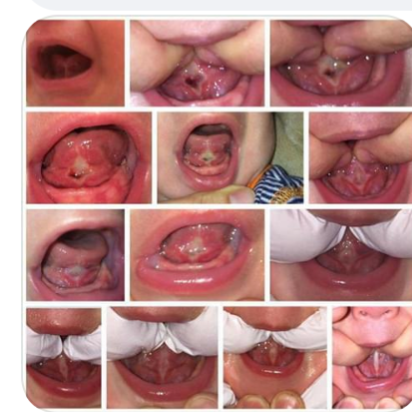
Menu
The goal is to heal correctly. Infection after tongue/lip or buccal (cheek) tie surgery is rare. Bleeding is usually light after surgery and usually resolves within a couple of minutes. Providers may request that babies attend their appointment hungry as feeding the baby at the breast or on a bottle immediately after the procedure is by far the most comfortable and effective way of stopping the bleeding.

The action of sucking naturally puts pressure on the wound. As the wound heals it turns white (sometimes with a yellow/slightly greenish tinge) to form a patch resembling a mouth ulcer and this is normal. In a jaundiced baby, the patch may turn orange due to the raised bilirubin level. The white patch usually develops within 48 hours and disappears within a week to 14 days.
As it heals it can appear to be lifting at the edges and in some babies, the edge can look dark red/orange. This is all part of normal healing. Some providers place sutures to prevent reattachment of the tissue, and others leave the wound open. It will depend upon the method used by the doctor. Recovery and healing can take 2-4 weeks. There is a healing period between 3-4 weeks known as contracture, in which the area will tighten up and you may think it is reattachment. The time frame for reattachment would be a minimum of 6-8 weeks post revision.
If someone has an open wound, it will look something like a diamond at the beginning. The goal is to facilitate healing by causing the wound to heal slowly, from the outside edges inward, instead of top and bottom healing together. The top and bottom triangles should not attach to each other. When there is correct healing, the sides of the diamond heal together, creating a new frenum. The goal is that the new frenum is long, lean, and limber allowing for adequate mobility.
The release does not mean immediate progress. It can take 6 weeks to 6 months for a baby to get used to using their new tongue correctly and how to use other muscles now that it is no longer restricted. Just like after any surgery, the area needs healing and therapy to get things working and functioning properly. For example, it may be myofunctional therapy, assistance by an International Board Certified Lactation Consultant (IBCLC), Suck Training for infants, chiropractic or osteopathic care, and more.
Coconut oil is not recommended as it may promote healing which can cause a more likely chance of reattachment. Consult with your doctor.
Please be aware that it is quite common to feel pain in the teeth, jaw, gums, and other surrounding areas of the mouth after the procedure. Excessive drooling is completely normal after surgery too. The increased mobility of the tongue and lips may temporarily stimulate salivary flow.
Avoid any foods that are hard to chew and swallow during the recommended recovery period. These include popcorn, taco shells, corn or potato chips, nuts, and crisp crackers. Also, skip rye bread with seeds, dry or coarse whole-grain cereals, and cake and bread with flax seeds or nuts. High temperature and spicy foods should be avoided as well.
Stretching Exercises: Stretching exercises are to prevent reattachment. Some people do stretching exercises with gloves (latex-free or white cotton gloves). Cold gloves can be helpful. Others prefer the option of using just clean bare hands. See what works best for you.
Pre-Release: Depending on the age of the child or adult, stretching exercises may be necessary with a myofunctional therapist for weeks before the procedure in order to achieve the best possible outcome. Do not skip this pre-release step.
On the day of the release: Carefully follow all stretching exercises given by your doctor performing the release and/or myofunctional therapist. Your doctor should provide post-care exercises including visuals and pain management protocol as well as explaining it all in person after the procedure. In general, begin stretches a few hours after the release and do them every 3-4 hours for 4-6 weeks. Some doctors may require you to do them more often. If given sutures, however, stretching exercises may differ and may not require immediacy so the stitches don’t pop off or pop open the wound. Please consult with your doctor.
Post-Release: After 6 weeks some individuals require stretches 4 times a day then lower to 2-3 times after the 10-week mark. It all depends on each individual case. Your body will try to resort to its old structure. Take the stretches seriously! Your baby may cry when doing exercises post-surgery but remember it is for their benefit.
Stretching Exercises
Stretching exercises are to prevent reattachment. Some people do stretching exercises with gloves (latex-free or white cotton gloves). Cold gloves can be helpful. Others prefer the option of using just clean bare hands. See what works best for you.
Pre-Release: Depending on the age of the child or adult, stretching exercises may be necessary with a myofunctional therapist for weeks before the procedure in order to achieve the best possible outcome. Do not skip this pre-release step.
On the day of the release: Carefully follow all stretching exercises given by your doctor performing the release and/or myofunctional therapist. Your doctor should provide post-care exercises including visuals and pain management protocol as well as explaining it all in person after the procedure. In general, begin stretches a few hours after the release and do them every 3-4 hours for 4-6 weeks. Some doctors may require you to do them more often. If given sutures, however, stretching exercises may differ and may not require immediacy so the stitches don’t pop off or pop open the wound. Please consult with your doctor.
Post-Release: After 6 weeks some individuals require stretches 4 times a day then lower to 2-3 times after the 10-week mark. It all depends on each individual case. Your body will try to resort to its old structure. Take the stretches seriously! Your baby may cry when doing exercises post-surgery but remember it is for their benefit.
A form of “reverse tummy time” – it helps with chin and neck extension. Most babies love it, and it’s especially great after a tongue-tie release procedure. In this video, it’s shown with the baby on a lap. The guppy can also be done with the baby’s head over the curve of a pillow or laying the baby in the reverse orientation on a “boppy lounger.”
Please be aware of pain management recalls. Do your research!
STAY AHEAD OF THE PAIN: This means not waiting until your pain is severe before you take your medication. If you wait until your pain is severe or increasing, it will be more difficult to control your pain, especially after the wait for the medication to be absorbed by your body and take effect.
Try a Medi Frida Pacifier Baby Medicine Dispenser
Try Pain Relief Suppositories if will not take orally
Freeze a baby toothbrush as a form of pain relief
Use a Baby Freezable Teether Pacifier
Put water in your soothie pacifier and then place it in the freezer for a couple of hours and use it as a homemade freezable teether pacifier
Place ice inside a Baby Fruit Feeder Pacifier Teething Teether
Offer the baby a sugar-water mixture (ask your doctor for the appropriate amount)
Babywearing & keeping the baby upright as much as possible so blood does not rush to the wound causing throbbing
Dissolve some arnica in ice water, soak a cotton ball, and put it under the tongue for a minute or however long it is tolerated
Use the fat on top of the breast milk after it has been chilled in the fridge and put that on the affected area
Skin to skin and warm baths (some prefer Epsom salt baths) after stretches. Ask your doctor if Epsom salt baths are appropriate for the age of your child
Options to freeze breast milk:
1) Freeze breast milk on a cookie sheet and break it into pieces
2) Freeze a flat, thin layer of breast milk in a Ziploc bag so it is easy to break off small pieces
3) Place breast milk in an ice tray with a pacifier set on top to be the handle
Comfort nursing – breastfeeding for another purpose besides feeding. It offers opportunities for:
Natural Remedies for upper lip swelling relief (puffy appearance): Please note for all remedies mentioned please consult with your doctor if the methods are appropriate for your particular situation. For example, it may not be suggested by your provider to put ice directly on the wound.
Adults:
Ice pops or ice chips to help ease the pain
Ice compress on the outside of the neck/throat areas
Have cold drinks
Other homeopathic remedies for wound management include serrapeptase pills. These pills are not for swallowing; rather the pill is opened and the powder is applied to the inside of the wound to prevent healing and reattachment. Please consult with your physician or specialist before using this approach to make sure they are in agreement.

